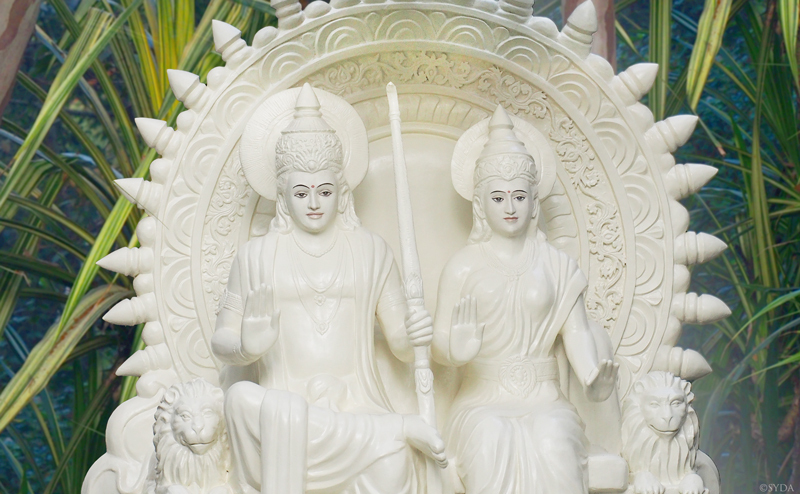Lord Rama, the Embodiment of Dharma

by Alka Jain
Rama is one of the Sanskrit names of God we often find in the namasankirtanas chanted on the Siddha Yoga path. For celebrations and satsangs the name of Lord Rama is called upon to invoke divine grace, to grant protection, and to open our hearts to the experience of love that is intrinsic to the Lord. Rama is a name for God and also for the inner divinity that is our very own Self.
Having grown up in Delhi, India, my earliest childhood memory of Lord Rama was hearing his name everywhere I went and in almost every conversation. People used Lord Rama’s name as a greeting, as a quick salutation between passersby, in moments of jubilation and happiness, and also in times of sadness and despair. Some would say in Hindi Jai Shri Ram (Hail Shri Ram!) or Jai Siya Ram (Hail Sita and Ram!) Others said simply, Ram Ram. My favorite was Jai Ram ji ki (Victory to Ram!) The name of Lord Rama is intricately and inextricably woven into the cultural mosaic of India for it is believed that continuously invoking Lord Rama drives away negative energies and brings about auspiciousness.
Lord Rama was the seventh avatar, or incarnation, of Lord Vishnu, the sustainer of the universe. Hence, the supreme being manifested in a human form to protect the good, destroy the evil, and re-establish order and righteousness in the world. Lord Rama is revered as maryada purushottama, “the upholder of dharma,” of righteous living.
The name Rama derives from the Sanskrit root ram which means “calm,” “to set at rest,” “to delight,” and also “to make happy.” Lord Rama is also known as Ramachandra (shining like the moon), Dasharatha-nandan (the delight of King Dasharatha, Rama’s father), and Raghava (hailing from the Raghu dynasty). Lord Rama is beloved, respected, and adored for the virtues he embodied: dharma, valor, chivalry, loyalty, compassion, love, obedience, courage, and equipoise. For many in India, Lord Rama personifies the characteristics of the ideal human being.
The great Sanskrit epic poem Ramayana (The Journey of Rama), written by the sage Valmiki, narrates the life of Lord Rama. The Ramayana is one of the longest and most ancient epics in world literature, consisting of nearly twenty-four thousand verses that recount events from Treta Yuga, the second eon according to the traditional reckoning of time in India.
Valmiki’s Ramayana was written in Sanskrit, the traditional scriptural language of India. In the sixteenth century the poet-saint Goswami Tulsidas retold the life of Lord Rama in the Avadhi dialect, a local vernacular in Uttar Pradesh, India, to make the story accessible to the layperson. Tulsidas’s version is known by the name Ram Charit Manas (The Lake of Lord Rama’s Deeds).
Throughout the Ramayana we read illustrations of Lord Rama’s steadfastness in manifesting divine virtues and his absolute commitment to upholding dharma in all his actions.
Rama was the crown prince of Ayodhya, but was exiled because King Dashrath’s youngest queen wanted her own son to be crowned king. Thus Rama roamed through forests accompanied by his wife, Sita, and his brother Lakshmana. For fourteen years, he lived a simple life, providing protection and relief to ascetics who were being harassed and persecuted by demons. Rama’s culminating deed was to vanquish the demon king Ravana, who had kidnapped Sita and taken her to the kingdom of Lanka, an island off the southern coast of India. The personification of evil, Ravana was the very opposite of dharma. In this exploit, Rama was assisted by Hanuman, the commander of an army of monkeys. Hanuman, who became a great devotee of Rama, was the epitome of service and loyalty, ever willing to go to any length to fight for righteousness alongside his Lord. Upon saving his wife and completing his years of exile, Lord Rama and company returned to Ayodhya where, amidst great jubilation, Rama was crowned king. Ramrajya (the reign of Lord Rama) is said to have lasted for eleven thousand years, which is a symbol for the everlasting reign of virtue.

Lord Rama is worshipped and celebrated in India through various joyful festivals.
Ram Navami, held on the 9th day of the new moon of the Indian month of Chaitra, which corresponds with March or April of the Gregorian calendar, honors Lord Rama’s birthday. On this day, devotees visit temples, read or recite stories of Shri Rama, and some fast before concluding the day with great feasts.
Dassera—the tenth day of the Indian month of Ashvin and just after the Navaratri festival, celebrated around September and October—marks Lord Rama’s victory over Ravana which symbolizes the victory of good over evil. During Dassera giant effigies of the ten-headed Ravana are filled with firecrackers and erected all over India. After dark, large crowds gather to behold the spectacle of an actor dressed as Rama shooting an arrow at Ravana. The effigy goes up in flames amongst the noise of firecrackers and the cheering crowds. The days leading up to Dassera are also known for the Ramlila, enactments of the Ramayana as a dance drama. When I was a child, we excitedly awaited this time of the year so that we could watch the various Ramlila productions. We were mesmerized by the heroic and compassionate acts of Lord Rama. Though we were young, the Ramlila taught us to ardently follow the path of righteousness.
Deepavali, the “Festival of Lights,” twenty days after Dassera, on the fifteenth day of the Indian month of Kartik, marks Lord Rama’s triumphant entry into Ayodhya. He arrived at night, his way lit by rows of diyas, “ghee lamps.” Deepavali honors the victory of light over darkness. On this day, people clean their homes, have a fragrant oil bath in the morning, and wear new clothes. They prepare all kinds of delicious foods which are then exchanged with friends and neighbors. An important part of the celebration is lighting and placing the diyas in and around one’s home. At night people gather outdoors to greet each other and light firecrackers. I recall my grandmother telling me that the loud noises of the firecrackers were to ward off evil spirits. Even today, where I live in Montreal, Canada, around the time of these festivals, many of my friends hold an akhanda path, which is an unbroken recitation of the Ram Charita Manas. During this twenty-four-hour recitation, my friends and I take turns, each reciting a particular section at a particular time. Between us, we recite the entire text continuously throughout the day and night.
On the Siddha Yoga path, we chant Lord Rama’s name and are also encouraged to cultivate the divine virtues he exemplified. I still recall, during my very first visit to Shree Muktananda Ashram in 1989, hearing the Lord’s name Shree Ram, Jay Ram, Jay Jay Ram being chanted in the Annapurna dining hall. In that moment, hearing Lord Rama’s name being chanted with such reverence, I knew deep in my heart that I was home—for I had been led to a path that is synonymous with the virtues of Lord Rama.
Jai Shri Rama!

This statue of Lord Rama and his wife, Sita, stands in the gardens of Gurudev Siddha Peeth,
the Siddha Yoga Ashram in Maharashtra, India.


